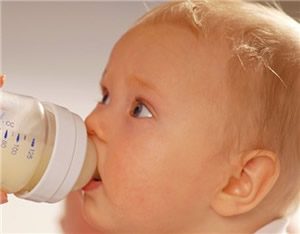How to Bottle Feed a Baby: A Comprehensive Walkthrough
Bottle-feeding plays a crucial role in many babies’ lives, providing essential nutrients and fostering a unique bond between parent and child. However, if you’re new to this experience, navigating the process can feel overwhelming. This detailed guide aims to empower you with the knowledge and skills to create a smooth and successful bottle-feeding journey for both you and your little one.
Essential Preparation: Ensuring Safety and Comfort
Cleanliness is Key:
Before each feeding, meticulously wash and sterilize all bottle-feeding equipment. This includes bottles, nipples, bottle brushes, and any other tools you’ll be using. Use hot, soapy water for washing, followed by proper sterilization according to the manufacturer’s instructions or using a steam sterilizer. This crucial step helps prevent the growth of bacteria and protects your baby’s delicate immune system.
Precise Milk Preparation:
- Formula Feeding: If using formula, meticulously follow the specific mixing instructions and ensure the water temperature is safe. Always use bottled or filtered water that’s been boiled and cooled to lukewarm (around body temperature) before mixing it with formula powder. This ensures the formula is properly diluted and prevents potential scalding from hot water.
- Breast Milk Feeding: If using pumped breast milk, gently warm it to a comfortable temperature, similar to breast milk. Several methods can be used, such as placing the milk container in a warm water bath or using a breast milk warmer. However, avoid overheating the milk, as it can destroy valuable nutrients.
Creating a Calm Environment:
Choose a quiet, distraction-free space where you and your baby can relax and focus on feeding. This could be a comfortable chair in your nursery, a quiet corner on the couch, or even your bed. Ensure the room is at a comfortable temperature and free from any loud noises or bright lights that might startle your baby.
Positioning and Comfort: Creating a Secure and Supportive Space
-
Cradling Your Little One: Gently cradle your baby in your arms, supporting their head and neck. You can choose a position that feels comfortable for both of you, such as sitting upright in a chair with your baby nestled against your chest, or lying down on your side with your baby facing you. Experiment and find a position that allows for easy access to the bottle and optimal support for your baby.
-
Holding the Bottle Steadily: Securely hold the bottle at an angle, ensuring the nipple remains filled with milk throughout the feeding. Avoid squeezing the bottle, as this can cause the flow rate to be too fast and overwhelm your baby. Additionally, refrain from propping the bottle against pillows or placing it in your baby’s mouth, as this can lead to choking or overfeeding.
Initiating Feeding: Gentle Cues and Encouraging Latch
-
Stimulating the Sucking Reflex: Gently touch the nipple to your baby’s lips, brushing it back and forth slightly. This can stimulate their natural sucking reflex and encourage them to open their mouth wide. Be patient and wait for your baby to actively show interest before attempting to insert the nipple.
-
Guiding the Nipple: Once your baby opens their mouth wide, gently guide the nipple inside, ensuring the entire base of the nipple rests comfortably against their lower gums. This helps them create a proper seal around the nipple and promotes effective sucking and swallowing.
The Feeding Process: Observing Cues and Maintaining Comfort
-
Pay Attention to Your Baby’s Cues: Throughout the feeding, closely observe your baby’s behavior. If they suck comfortably, swallow the milk, and seem content, the flow rate is likely appropriate. However, watch for signs of frustration, like coughing, choking, or pushing the bottle away, which might indicate the flow rate is too fast.
-
Bonding Through Communication: Talk softly and sing songs to create a calming and reassuring atmosphere. Make eye contact and smile to connect with your baby and foster a positive association with bottle-feeding. This not only makes the experience more enjoyable for both of you but also strengthens the parent-child bond.
-
Pacing for Comfort: Don’t force the bottle on your baby. Instead, allow them to take breaks and swallow at their own pace. This prevents overfeeding and discomfort, as babies have small stomachs and need time to digest the milk. Offer frequent burps throughout the feeding, especially after they finish half the bottle, to release any swallowed air and prevent gas buildup.
Ending the Feeding: Recognizing Cues and Gentle Disengagement
- Reading Your Baby’s Signals: As your baby feeds, watch for signs that they are full, such as turning away from the bottle, closing their mouth firmly, or pushing the bottle away with their hands. These cues indicate that they are no longer
hungry and forcing further feeding can lead to discomfort or even spitting up.
- Removing the Bottle Gently: Once your baby shows signs of satiety, gently remove the bottle from their mouth. Avoid pulling it away abruptly, which might cause them to gag or choke. Instead, slowly tilt the bottle downwards while pulling it out of their mouth.
Additional Tips for a Positive Bottle-Feeding Experience
- Explore Holding Positions: Experiment with different holding positions to find what works best for you and your baby. Some babies might prefer to be held upright, while others might be more comfortable lying down on their side.
- Patience and Persistence are Key: Remember, every baby is different and it might take some time for your baby to adjust to bottle-feeding. Be patient, persistent, and offer the bottle regularly. Create a positive and consistent feeding routine, and your baby will eventually become comfortable and efficient at bottle-feeding.
- Seeking Professional Support: If you encounter any difficulties or have concerns about your baby’s feeding, don’t hesitate to seek professional help. Consult your pediatrician or a lactation consultant. They can provide personalized advice, address any specific challenges you might face, and ensure your baby is receiving proper nourishment and developing healthy feeding habits.
Conclusion: Building a Positive Feeding Journey
Bottle-feeding can be a rewarding and enriching experience for both parents and babies. By following these detailed steps, adapting them to your baby’s unique needs, and remaining patient and consistent, you can establish a positive and healthy feeding routine. Remember, the most important element is to create a calm and loving environment where your baby feels safe and secure, fostering a strong bond that extends beyond the act of feeding itself.
